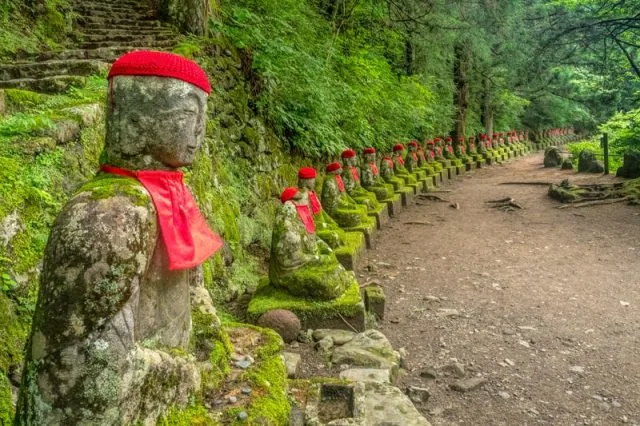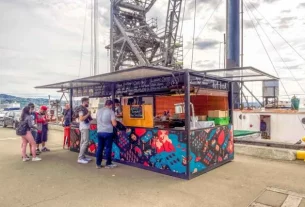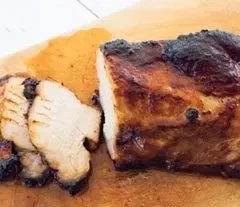The historic shrines and temples of Nikko in Tochigi prefecture are an easy 2-hour train ride from Tokyo making a Nikko day trip an ideal way to experience the history and natural beauty of the region. The history of the sacred UNESCO World Heritage site dates back to the 8th century and its setting within the densely forested mountains makes it a welcome respite from the city.

While the concentration of shrines and temples is the most widely known attraction in the area there is so much more to see and do in Nikko if you can extend your stay a little longer. We’ve covered many of the other options for the wider region together with where to eat, play and stay in our full Nikko guide article.
The World Heritage site itself is massive and the focus of a Nikko day trip itinerary. It’s made up of over 100 different structures that are all listed as either National Treasures or important cultural properties. When you stop to consider the size and scale of that you really do need a full day in this part of Nikko.
Table of Contents
Getting to the Nikko World Heritage area
Nikko is on our list of great day trips from Tokyo, it’s perfect for first time visitors. You can get here by train from the city in under 2 hours and the main attractions are a relatively easy 2 km walk from the station or you can take the short bus ride up to the World Heritage area.
Personally I recommend the bus as there is a lot of climbing up and down mountain paths around the shrines and temples during the day if you want to see it all or even the highlights.

There are 2 different train companies that run up to Nikko from Tokyo, Japan Rail (JR) and Tobu. If you have an active JR pass you can definitely use it and travel by Japan Rail, otherwise I prefer Tobu. It’s simpler with no connection required between Tokyo and Nikko, it usually works out a little faster, and the station in Nikko is slightly close to the attractions.
Nikko day trip using Tobu trains
Asakusa in Tokyo is the hub for Tobu Railways, they have their own station here that is easy to locate from the subway station if you are coming in from another part of Tokyo and there are a number of shops between the stations with a great 7-Eleven almost opposite that has an incredible selection of onigiri and other baked goods and snacks for breakfast on the train if you are headed off early.

The direct train is the Tobu Limited Express, Kegon and it takes 1 hour and 50 minutes from Asakusa at a cost of Y2860 or Y5720. These trains are really comfortable seating, the configuration has 2 seats on either side of the aisle, luggage racks overhead, foot rest, fold down table, drink bottle holder and magazine pocket.
You can save even more by using the Nikko Pass World Heritage Area which includes the train from Asakusa to Nikko and the bus from the station around the Nikko Temples and Shrines World Heritage area. If you are buying the pass for this day trip you will want the World Heritage not All Areas version, it’s quite a bit cheaper as you aren’t paying to get out to the outer areas of Nikko that require a multi day trip like the waterfalls, lakes, onsen and national park.
Travelling by JR train to Nikko
The fastest JR option takes the shinkansen (bullet train) from Tokyo to Utsunomiya station in Tochigi prefecture then switch to the local JR Nikko line for the remainder of the trip. From Tokyo station it should take just on 2 hours including switching trains and will cost Y5880 one way or Y11760 return. That’s 10 minutes longer, a bit more fuss changing platforms and trains, and twice the price of Tobu so we’d only choose this option if we had an active JR pass we wanted to make use of.
If you are unsure what the JR Pass is, or whether you should get one, I have an article that covers whether a Japan Rail pass is worth it, including how to use it and how to work out for your own trip whether to invest or not. Read this before you buy one, they can be amazing, we’ve purchased them many times but NOT every time and too often now I’ve heard of travel agents selling a pass to first time visitors when they just aren’t good value for their itinerary.
Shinkyo Bridge
The Shinkyo Bridge is the first iconic sight from the area you will likely see as you make your way up from the station to the famous shrines and temples of Nikko. You will pass it whether you walk up from the station or take the bus.
This bridge has been a crossing to the temples and shrines beyond since 1636 but it replaced a crossing at the site that dates back even beyond that. It’s quite a sight in all seasons but in the early summer when it is surrounded in lush greenery, the turquoise water below still icy cold, it is particularly striking.

While you can walk across the heritage bridge for a small fee and perhaps feel what it was like to walk in the footsteps of feudal lords and samurai hundreds of years before, it is better viewed from the traffic and foot bridge that runs parallel to it just 50 metres further down the river.
If you have the Tobu Pass or an all day bus ticket the Shinkyo bridge stop is an easy one to find when you are ready to head back to the station or continue further on. It is conveniently located close to the temples and shrines on one side and some interesting shops and lunch spots just slightly further down the street on the other.
The shrines and temples of Nikko
These are by no means all the shrines and temples in Nikko, what it refers to is the UNESCO World Heritage listing for the site including the important historical assets within a confined geographical area, for simplicity referred to as the Nikko World Heritage site or the Shrines and Temples of Nikko.
We first visited Nikko independently during spring in 2010 and loved the natural beauty, history and serenity. I’ve been back a couple of times over the years and the photos you’ll see here are from different trips, if you picked up on a seasonal difference from the remnants of snow to lush green summer foliage, that’s the reason.
Tickets are required to enter each of the temple areas and are not covered within the Tobu passes, the fees individually are small but it can be a bit confusing as there are some combinations available if you know where you will be going that are slightly cheaper than buying seperate tickets. There does not appear to be a single ticket for all the temples, shrines and mausoleums.
Nikko Rinno-ji Temple
You will usually start to explore the area from Rinnoji Temple, this is the one closest to the bridge if you are walking and the first stop within the temples area if you are coming in on the bus. Perhaps you should also start here as it is the foundation of all the temples in the area being founded by Shodo Shonin, the Buddhist monk who introduced Buddhism to Nikko in the 8th century.

The main hall at Rinnoji is the Sanbutsudo Hall, these hoardings around the building were a familiar site with a renovation on the hall taking the best part of a decade to complete but they were finished in July 2019.
The hall houses a set of three large wooden statues lacquered in gold, one of Amida Buddha (Amitābha), Senju-Kannon who is depicted with 1000 arms and Bato-Kannon who is depicted with a horse head. Kannon in Tibetan Buddhism is Avalokiteshvara, Goddess of mercy. Here the 3 deities together are regarded as Buddhist manifestations of Nikko’s three mountain gods enshrined at Futarasan Shrine.
Other important aspects of Rinnoji are the treasure house and Shoyoen garden which are visited together under a separate entry ticket to the rest of the temple (Y300) or combined with the main hall entry. We’ve been through the garden in spring but it is best known for autumn leaves viewing in early November.
Nikko Toshogu Shrine
Toshogu Shrine is the mausoleum of Tokugawa Ieyasu, founder of the Tokugawa Shogunate that ruled over Japan for 250 years until the Meiji Restoration in 1868 when power was returned to the Emperor. Ieyasu was entombed at Toshogu in 1617 but the complex was significantly enlarged and enhanced by his Grandson, Iemitsu, in the early 17th century.





The elaborate decoration seen here is unusual in Japan and as Buddhism and Shinto weren’t separated until the Meiji Restoration you will see elements of both throughout the complex. For historical interest, the sheer scale, natural beauty and design this is one you will want to allocate a fair amount of time to. There are many individual areas as you progress through the shine grounds and wind your way up through the hillside forest.
The 5-story pagoda Toshogu Gojunoto
The highly ornate and immaculately maintained pagoda that stands here today was built in 1818 by Sakai Tadayuki and is now listed as an important cultural property. The original pagoda was built to enshrine Tokugawa Ieyasu, the first Tokugawa shogun and was dedicated in 1648, it stood here until destroyed by fire in 1815.

Like the rest of the Toshogu Shrine, it is far more ornate than typically seen in pagodas and temple buildings across Japan. The only other place I’ve seen a similar level of intricate detail and colour, on a much smaller scale, is at Yakuo-in on Mt Takao where some of the temple buildings behind the main hall have similarities. Takao is another great day trip if you like to spend some time in nature not too far from the city.
Nikko Futarasan Shrine
Make your way to Futarasan Jinja (shrine) along the cedar corridor that starts near the 5-story pagoda at Toshogu. You will feel dwarfed by the enormous and majestic cedars that tower above you as you walk through to the shrine and Taiyuin beyond that.

This is a much older complex than Toshogu, it was founded in 782 by Shodo Shonin, the same Buddhist monk that founded Rinnoji Temple. Entry is free to most of the shrine grounds and the Shinkyo Bridge seen on the way up to the temples and about a 1-kilometre walk away also belongs to this shrine.
Futarasan is another name for Mt Nantai a volcanic peak in the Nikko National Park, the shrine is dedicated to the deities of three important mountains in the area, Mt Nantai, Mount Nyoho and Mount Taro.
Taiyuin
Taiyuin is the mausoleum of Tokugawa Iemitsu, grandson of Tokugawa Ieyasu, the founder of the Tokugawa Shogunate. You might be tempted to skip it if you are tired after a day on your feet or ready for lunch but don’t, while it is true that in proper respect for Ieyasu it was constructed to be more modest it is still an incredible site housing 22 registered National Treasures, a lavishly ornate prayer hall and exceptional craftsmanship.

You can buy the ticket individually for this one or it can be purchased as a combined ticket with Sanbutsudo at Rinno-Ji.
Kanmanguifuchi Abyss
If you have heard of Kanmanguifuchi Abyss it was probably alongside a photo similar to the one I have taken below. These Jizo statues represent the guardian deity of children and travellers but they are tricky too, count them as you go in and as you go back out, everyone comes up with a different number.

The Abyss or gully has a river running to the right of the path in this photo and hills rising up on both sides making it damp and cool, the perfect environment for moss growing on the many stone statues, steps and retaining walls.
The river itself isn’t wide but is turbulent in parts as it winds through the bottom of the gorge. The sounds of the rushing water combined with the bird song and cicadas in summer are very soothing. We passed a monk from the temple but no one else on the path when we visited adding to the appeal of the spot.
A Nikko day trip is a fantastic inclusion on an itinerary and quite easy to do from a base in Tokyo but the less visited mountainous area of Okunikko is worth extending for a night or two if you can. This will give you time to get out to attractions such as Kegon Falls, Lake Chuzenji, Edo Wonderland or Kinugawa onsen. You’ll find more about the attractions, how to get around and where to stay in the wider area in our comprehensive Nikko visitors guide.
If you found this article useful please consider saving it to Pinterest. It makes it easy for you to find it again, it helps us, and it helps other travellers to find the information they are looking for.



